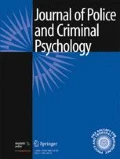Abstract
Perjury is a deception that occurs within the legal system. Research indicates that legal personnel, including police officers, detectives, and secret service agents, detect deception slightly above chance levels (Bond and DePaulo 2006). Scant research has been conducted to examine the frequencies and motivations of perjury. Thus, we conducted two studies to explore the rates of perjury and incentives to engage in perjury. Study one examined the reported frequencies of perjury, finding that it occurs in 29.9% of the interactions with legal personnel. Study two was designed to examine perjury-like behaviors using the Ariely (2012) shredder paradigm. Over half (54%) of participants in study 2 engaged in perjury-like behaviors and those who received money as an incentive were equally likely to engage in perjury behaviors as those who did not. Implications for practitioners and researchers are discussed.



Similar content being viewed by others
References
Ariely D (2012) The (honest) truth about dishonesty: how we lie to everyone – especially ourselves. Harper, New York
Blair JP, Levine TR, Shaw AS (2010) Content in context improves deception detection accuracy. Hum Commun Res 36:423–442. https://doi.org/10.1111/j.1468-2958.2010.01382.x
Bogaard G, Meijer EH, Vrij A, Merckelbach H (2016) Strong, but wrong: lay people’s and police officers’ beliefs about verbal and nonverbal cues to deception. PLoS One 11(6):1–19. https://doi.org/10.1371/journal.pone.0156615
Bond CF, DePaulo BM (2006) Accuracy of deception judgements. Pers Soc Psychol 10(3):214–234
Colwell LH, Miller HA, Miller RS, Lyons J, Phillip M (2006) U.S. police officers’ knowledge regarding behaviors indicative of deception: implications for eradicating erroneous beliefs through training. Psychol Crime Law 12:489–503. https://doi.org/10.1080/10683160500254839
Criminal law (1999) Perjury - Sixth circuit sustains perjury conviction for answer to question with mistaken premise. United States v. DeZarn, 157 F.3d 1042 (6th Cir. 1998). Harv Law Rev 112(7):1783–1788. https://doi.org/10.2307/1342420
Curtis DA, Hart CL (2015) Does Pinocchio’s nose grow in therapy? Therapists’ attitudes and beliefs toward client deception. Int J Adv Couns 375:279–292. https://doi.org/10.1007/s10447-015-9243-6
Curtis DA, Hart CL (2019) Deception in psychotherapy: frequency, typology and relationship. Couns Psychother Res 20:106–115. https://doi.org/10.1002/capr.12263
DePaulo BM, Kashy DA, Kirkendol SE, Wyer MM, Epstein JA (1996) Lying in everyday life. J Pers Soc Psychol 70:979–995
Dickens CR, Curtis DA (2019) Lies within the law: therapist’ beliefs and attitudes about deception. J Forensic Psychol Res Pract 19:359–375. https://doi.org/10.1080/24732850.2019.1666604
Ekman P (1985) Telling lies: clues to deceit in the marketplace, politics, and marriage. W. W. Norton & Company, New York
Ekman P, O’Sullivan M (1991) Who can catch a liar? Am Psychol 48:913–920
Granhag PA, Strömwall LA (2004) The detection of deception in forensic contexts. Cambridge University Press, Cambridge
Green SP, Kugler MB (2012) Public perceptions of white-collar crime and culpability: bribery perjury, and fraud. Law Contemp Problems 75(33):33–59
International Business Times (2012) Shellie Zimmerman, George Zimmerman’s wife, arrested for perjury in hiding legal defense fund money. International Business Times
Levine TR (2014a) Encyclopedia of deception. SAGE Reference
Levine TR (2014b) Truth-default theory (TDT): a theory of human deception and deception detection. J Lang Soc Psychol 33:378–392
Masip J, Herrero C (2015) Police detection of deception: beliefs about behavioral cues to deception are strong even though contextual evidence is more useful. J Commun 65:125–145
Mazar N, Amir O, Ariely D (2008) The dishonesty of honest people: a theory of self-concept maintenance. J Mark Res 45:633–644
McCornack SA, Morrison K, Paik JE, Wisner AM, Zhu X (2014) Information manipulation theory 2: a propositional theory of deceptive discourse production. J Lang Soc Psychol 33(4):348–377. https://doi.org/10.1177/0261927X14534656
McKoski RJ (2013) Prospective perjury by a criminal defendant: It’s all about the lawyer. Arizona State Law J 44:1575–1645
Motivans M (2015) Federal justice statistics, 2012- statistical tables. US Department of Justice Bureau of Justice Statistics
Nisbett RE, Caputo C, Legant P, Marecek J (1973) Behavior as seen by the actor and as seen by the observer. Journal of Personality and Social Psychology 27(2):154–164
Rogers R, Bender SD (2018) In: Rogers R, Bender SD (eds) Clinical assessment of malingering and deception, 4th edn. Guilford Press, New York
Samaha J (2014) Criminal lie, 5th edn. Wadsworth Cengage Learning, Belmont, CA
Serota KB, Levine TB (2015) A few prolific liars: variation in the prevalence of lying. J Lang Soc Psychol 34(2):138–157. https://doi.org/10.1177/0261927X14528804
Serota KB, Levine TR, Boster FJ (2010) The prevalence of lying in America: three studies of self-reported lies. Hum Commun Res 36:2–25. https://doi.org/10.1111/j.1468-2958.01366.X
Skinner BF (1938) The behavior of organisms: an experimental analysis. D. Appleton-Century Company, incorporated, New York, NY
Sooniste T, Granhag PA, Strömwall LA (2017) Training police investigators to interview to detect false intentions. J Police Crim Psychol 32:152–162. https://doi.org/10.1007/s1189-016-9206-9
United States Courts (2015) Combined filings of civil cases and criminal defendants in the district courts. US District courts – judicial business. Retrieved from: http://www.uscourts.gov/statistics-reports/us-district-courts-judicial-business-2015
Vrij A (2008) Detecting lies and deceit: pitfalls and opportunities. Wiley, Chichester
Vrij A, Mann S (2001) Telling and detecting lies in high-stake situation: the case of a convicted murderer. Appl Cogn Psychol 15:187–203
Yap AJ, Wazlawek AS, Lucas BJ, Cuddy AJC, Carney DR (2013) The ergonomics of dishonesty: the effect of incidental posture on stealing, cheating, and traffic violations. Psychol Sci 24(11):2281–2289. https://doi.org/10.1177/0956797613492425
Funding
This study was funded by a Graduate Research Fellowship Program from Angelo State University.
Author information
Authors and Affiliations
Corresponding author
Ethics declarations
Conflict of Interest
The authors declare that they have no conflict of interest
Ethical Approval
All procedures performed in studies involving human participants were in accordance with the ethical standards of the institutional and/or national research committee and with the 1964 Helsinki declaration and its later amendments or comparable ethical standards.
Informed Consent
Informed consent was obtained from all individual participants included in the study.
Additional information
Publisher’s Note
Springer Nature remains neutral with regard to jurisdictional claims in published maps and institutional affiliations.
Appendix A
Appendix A






